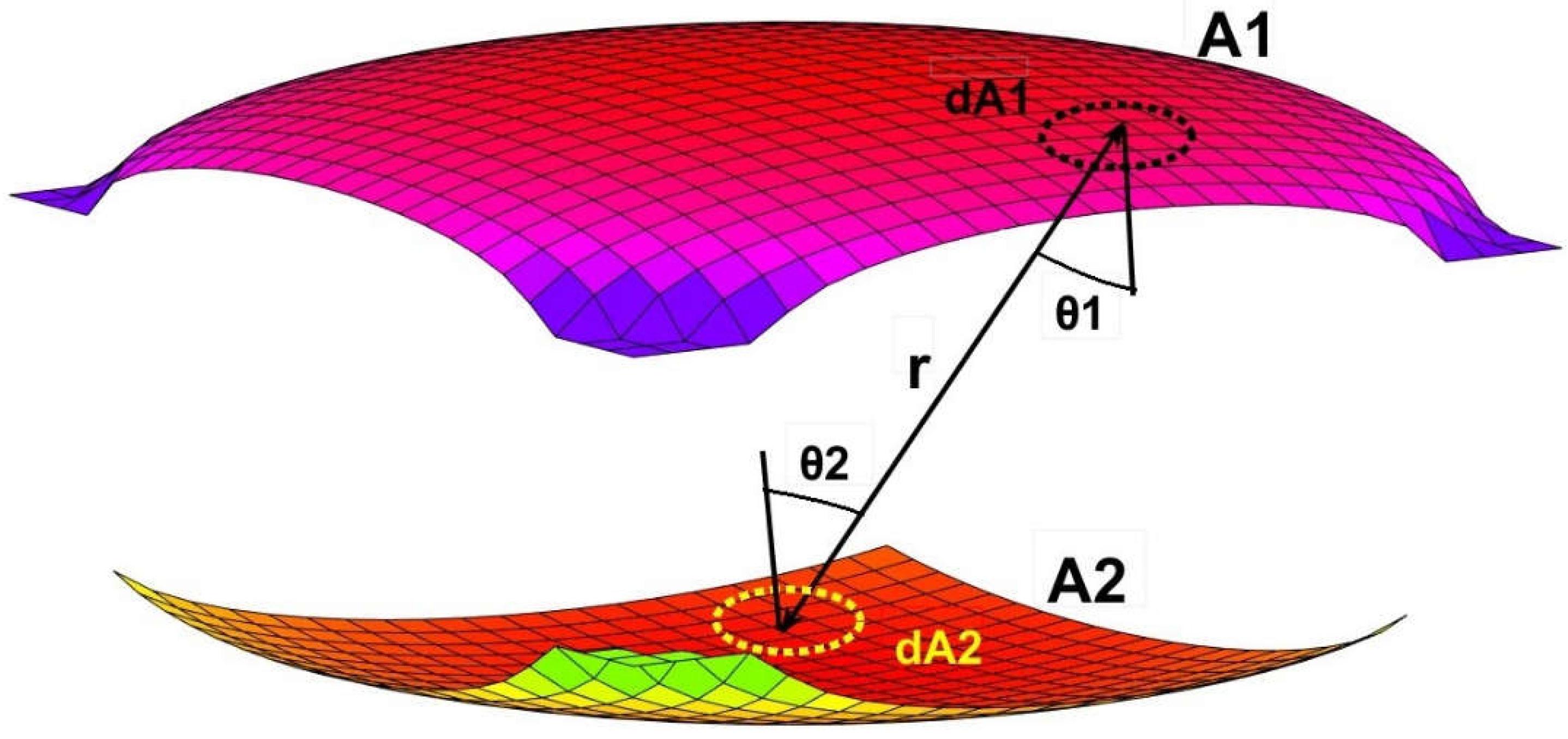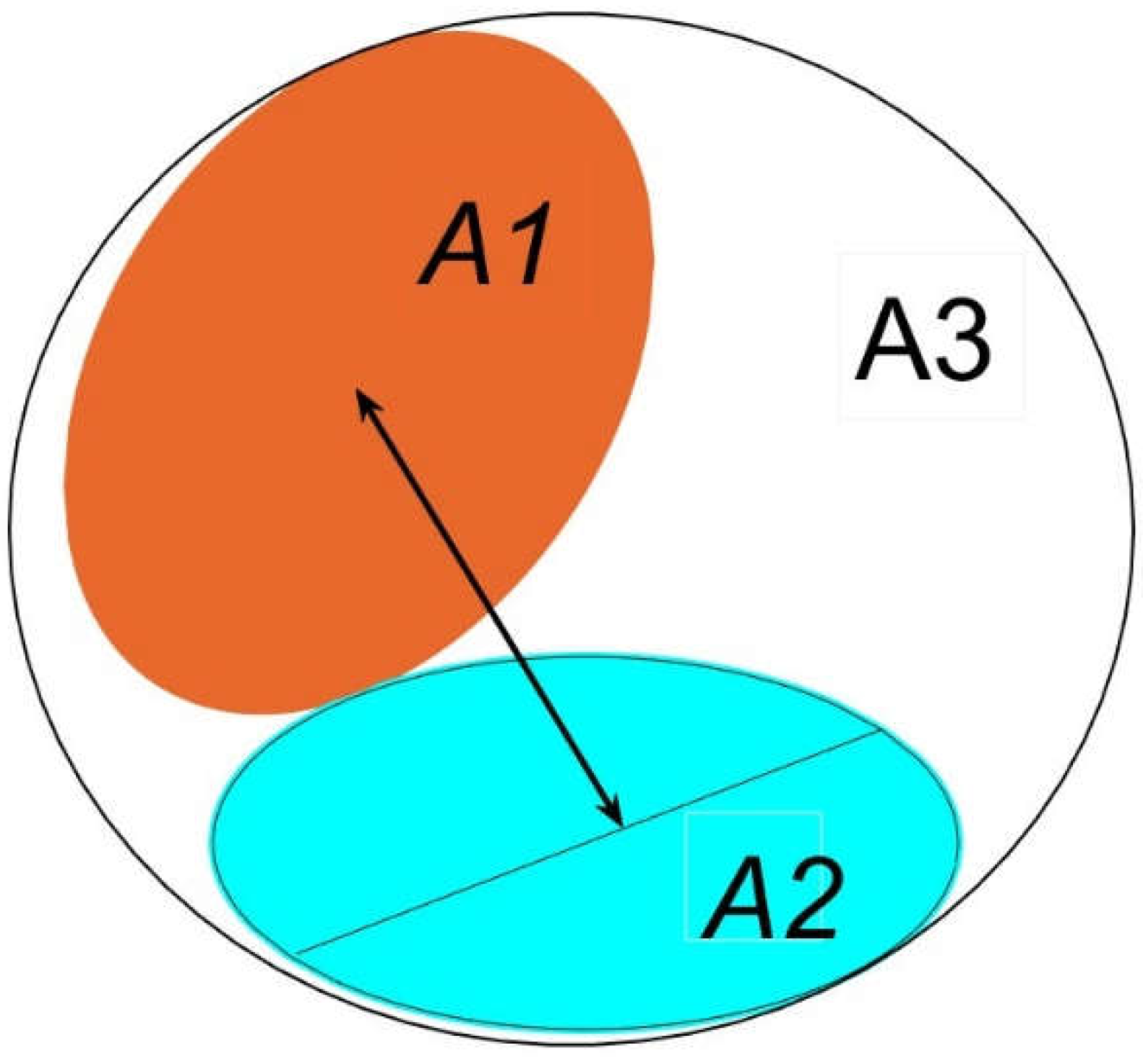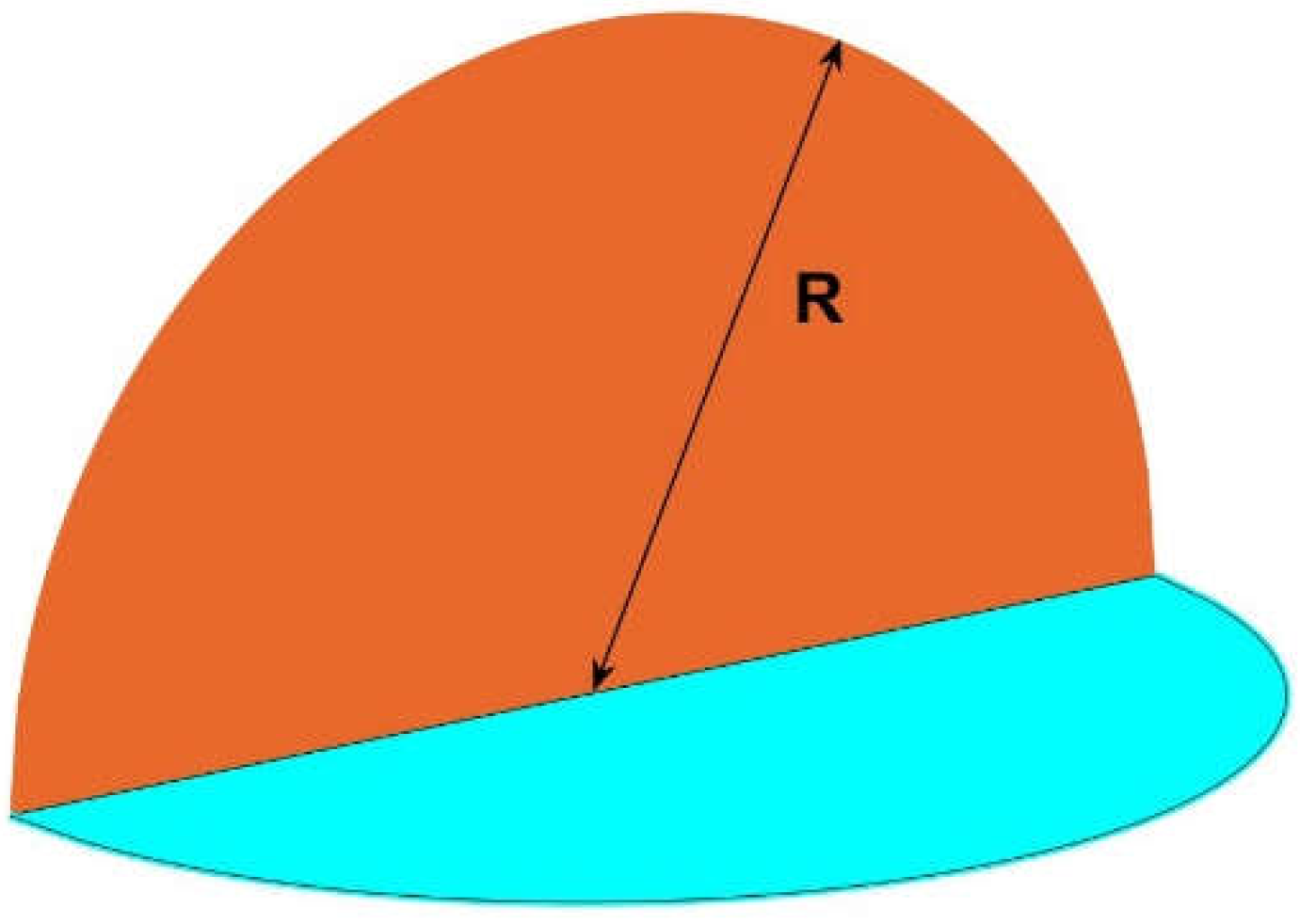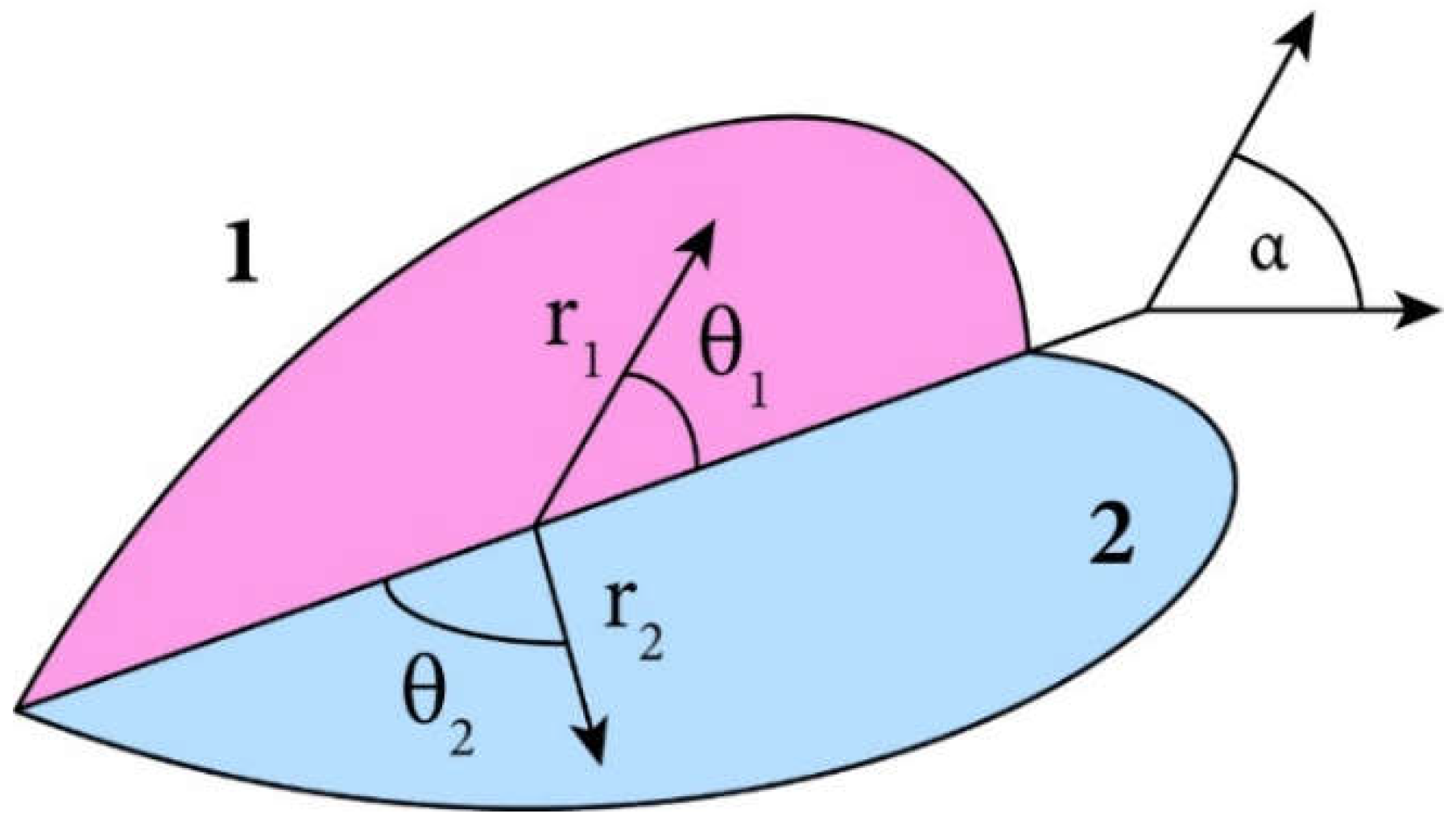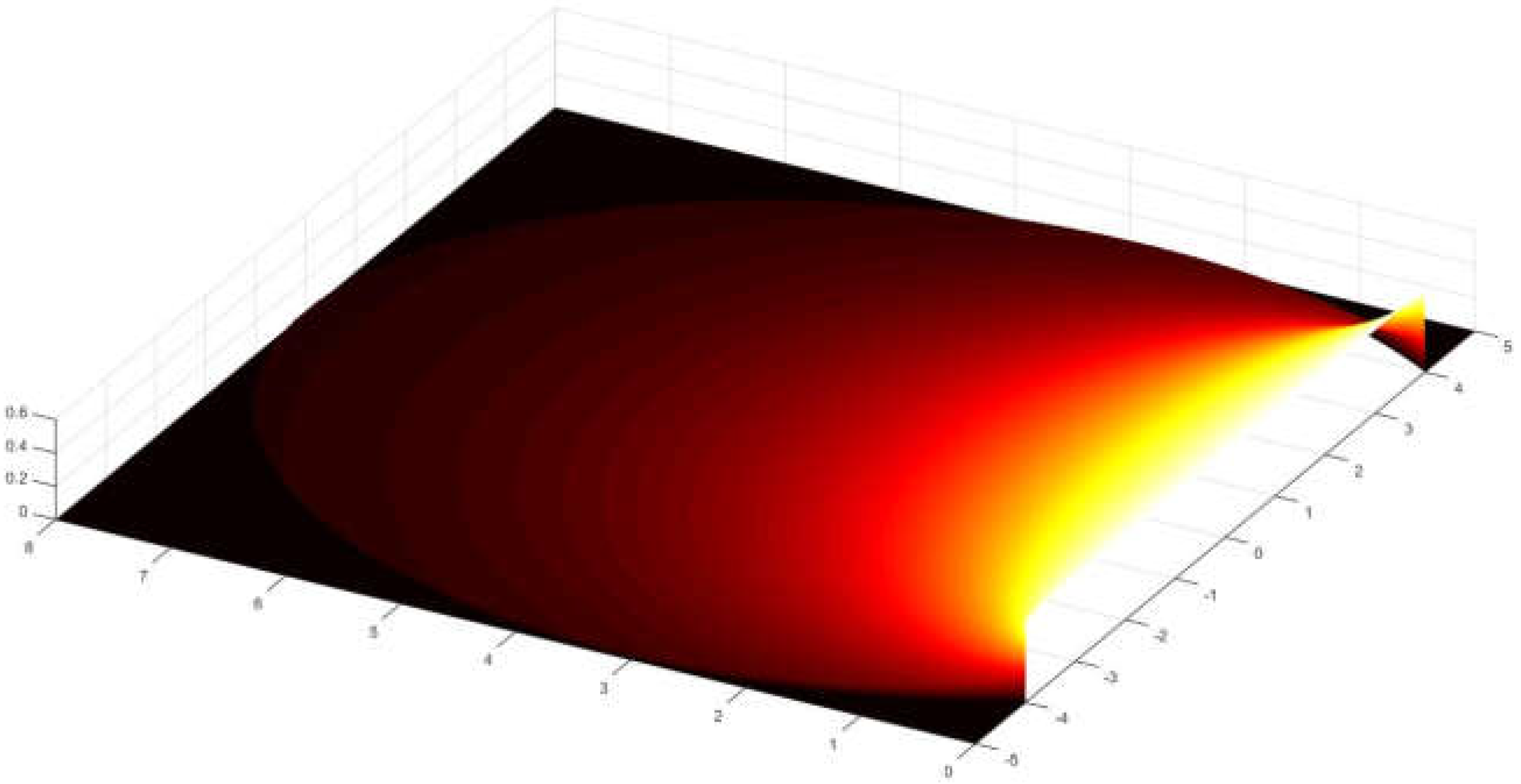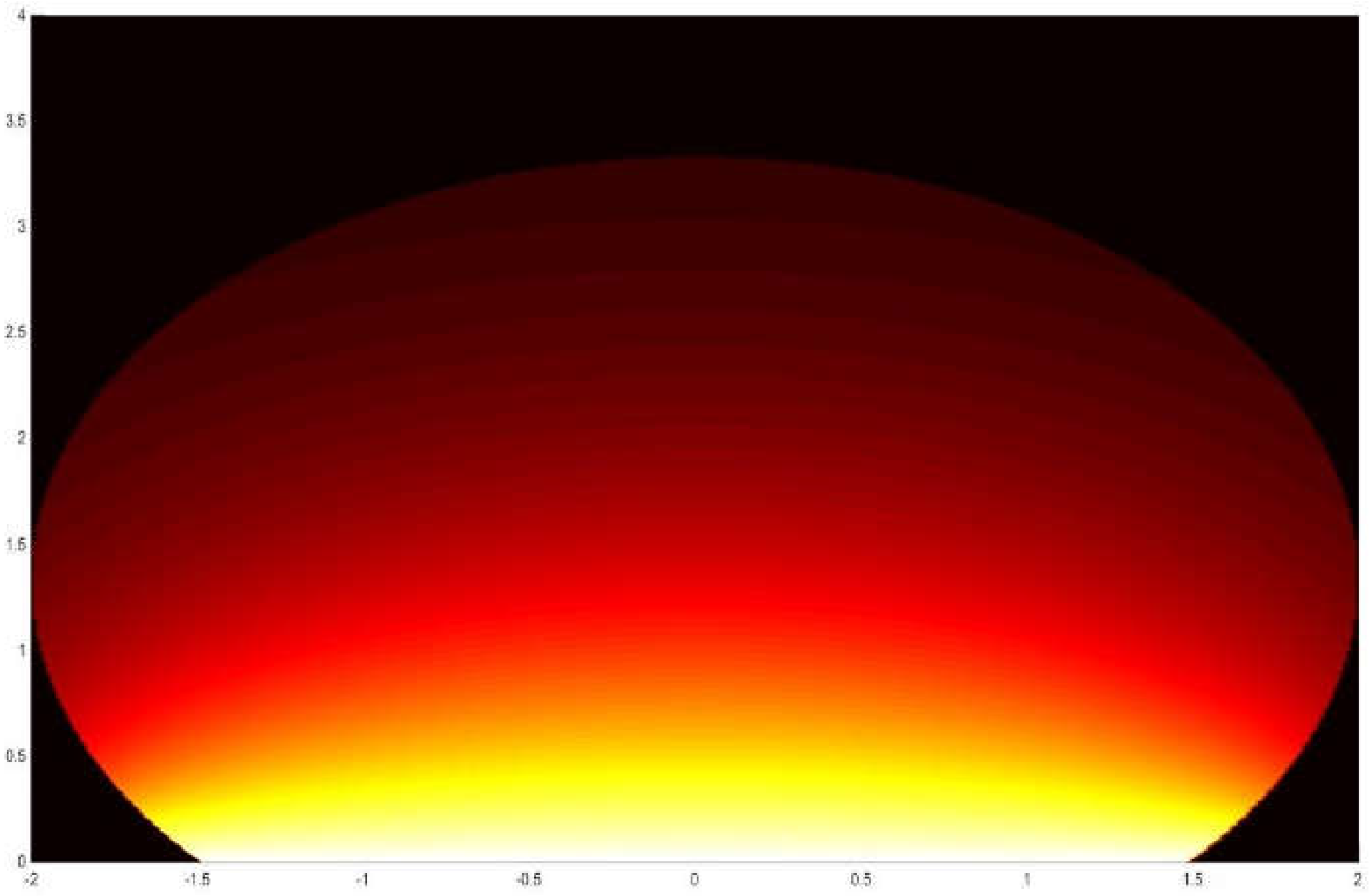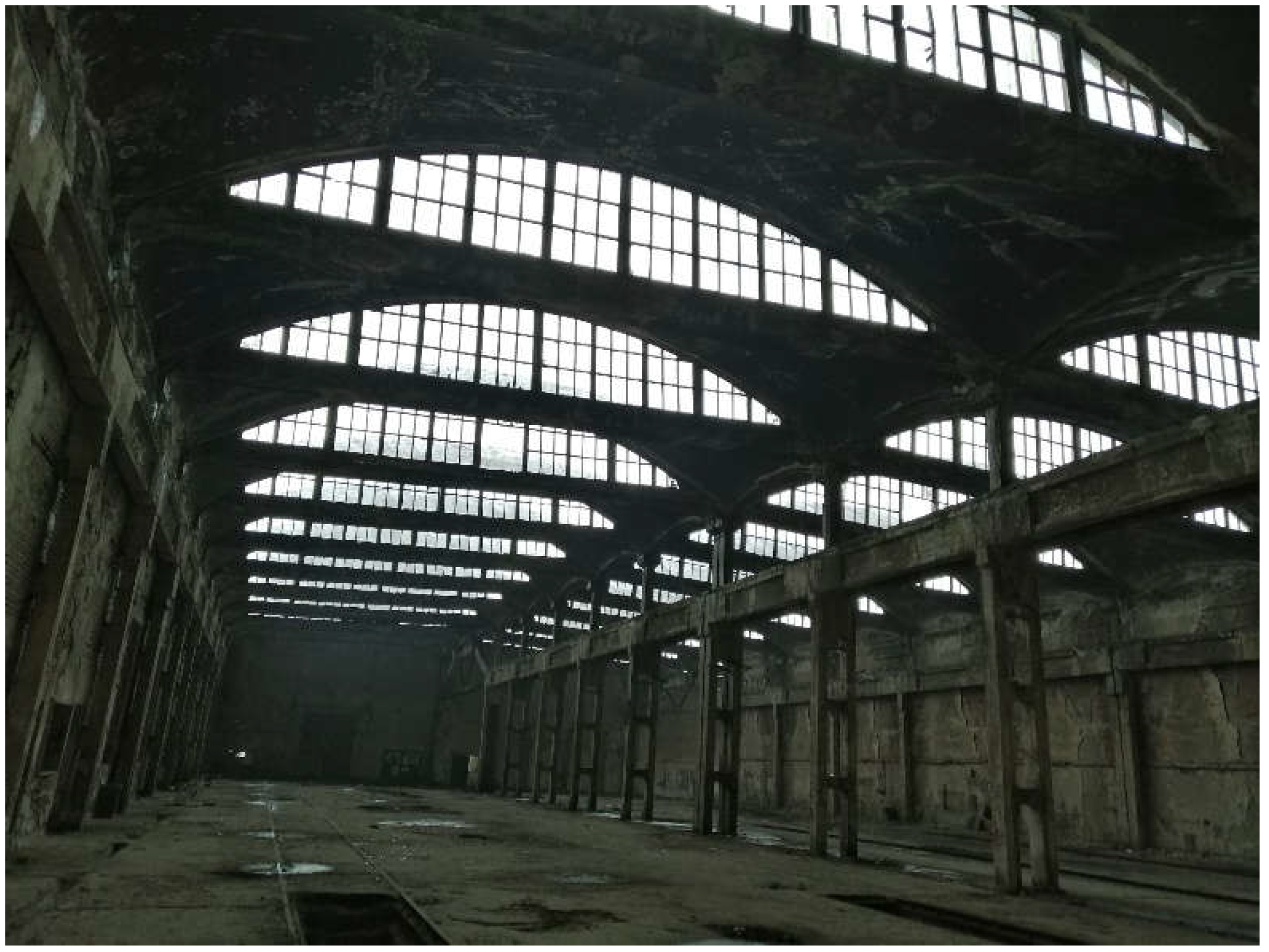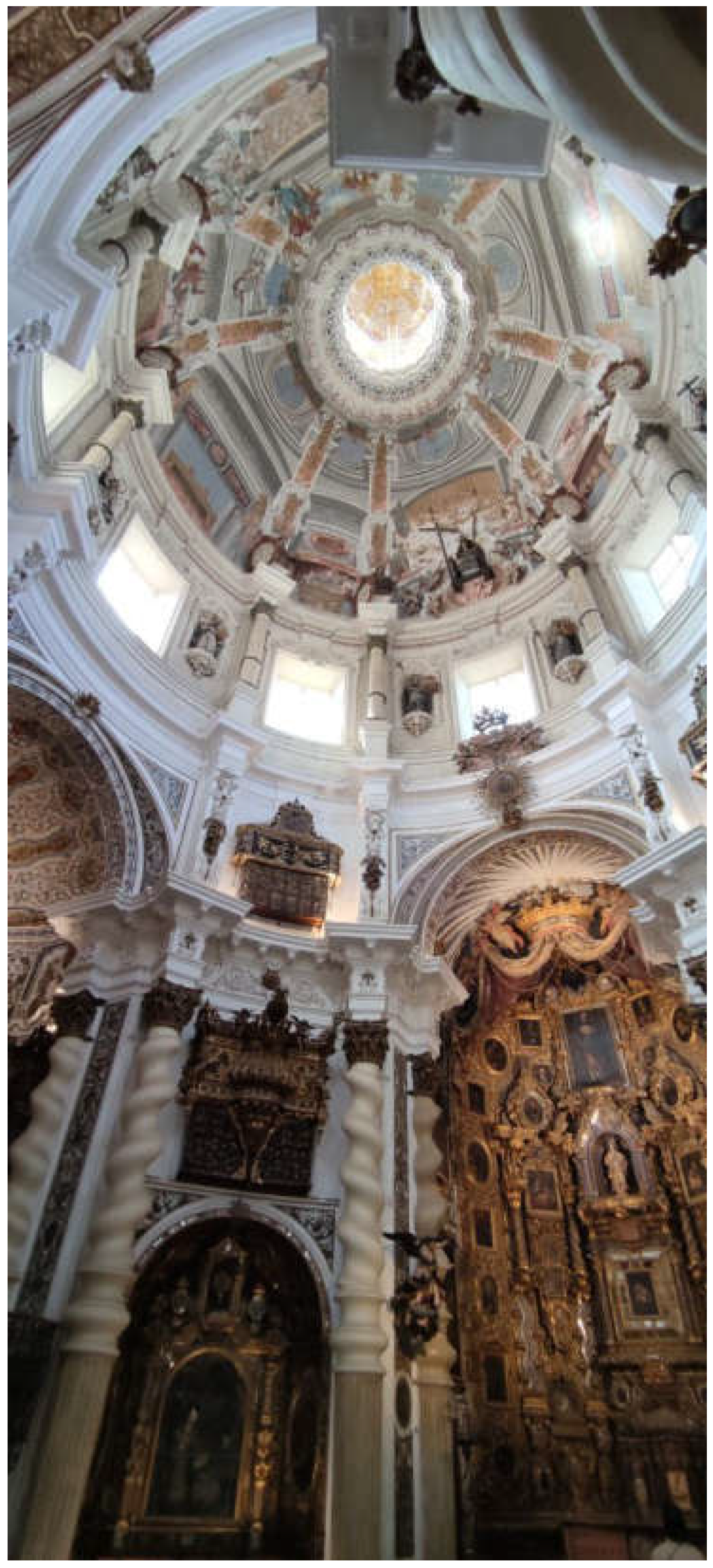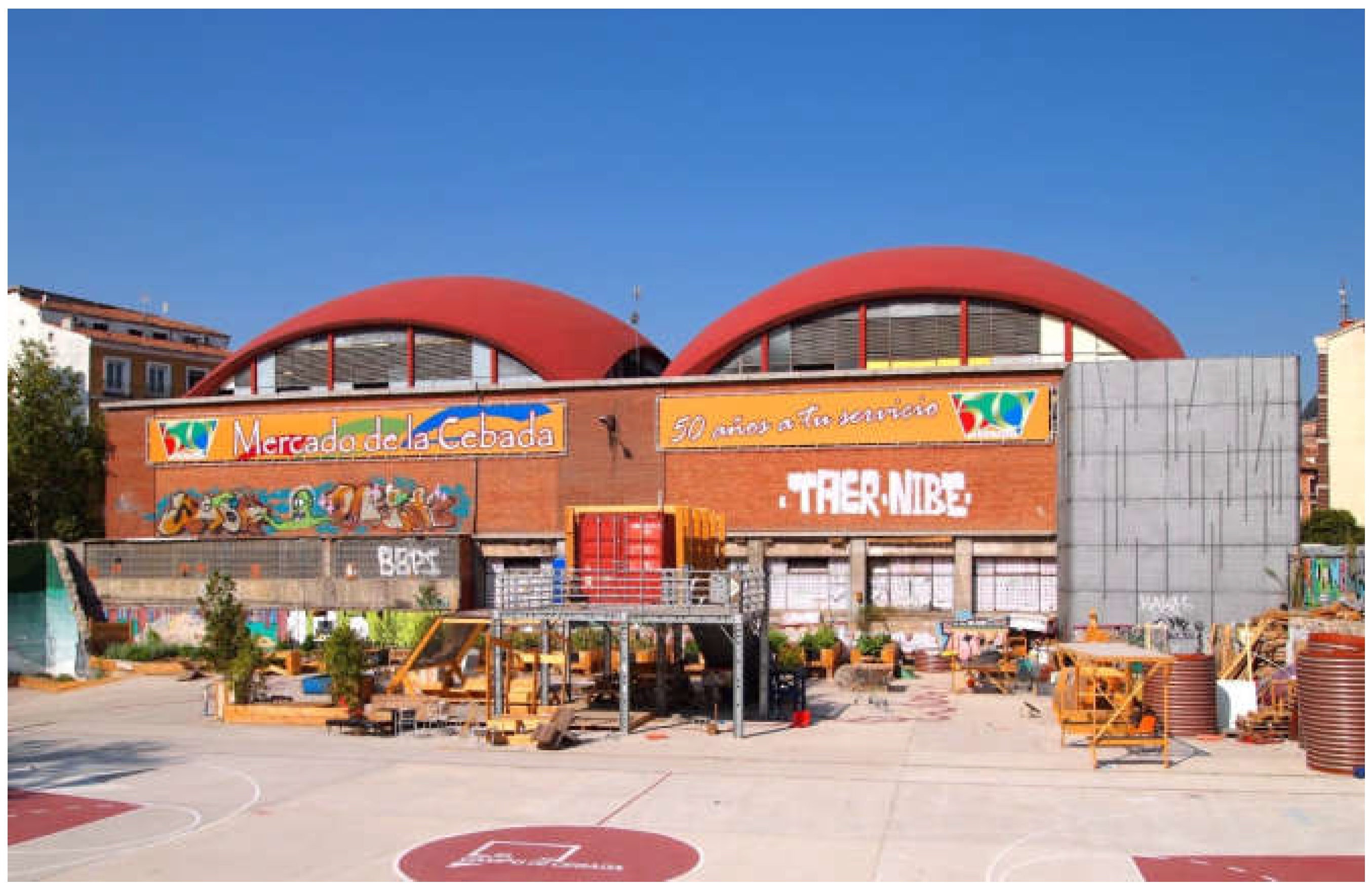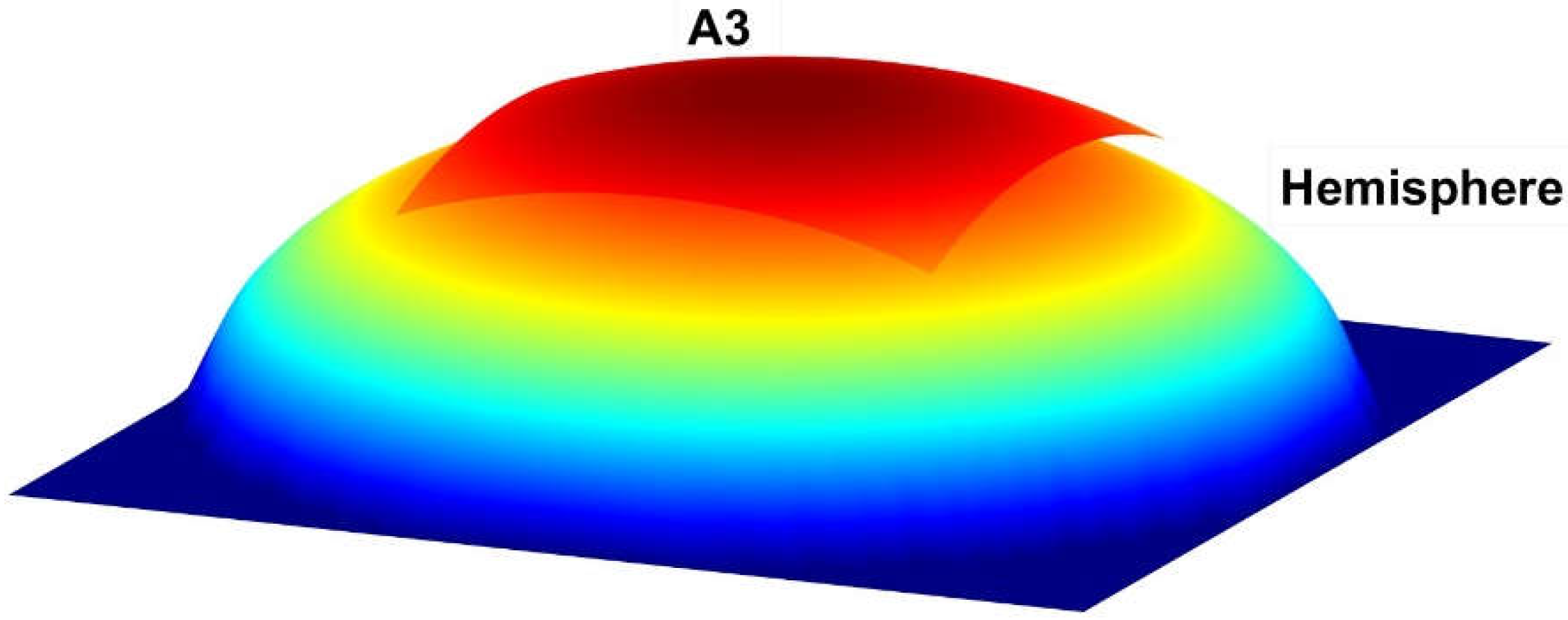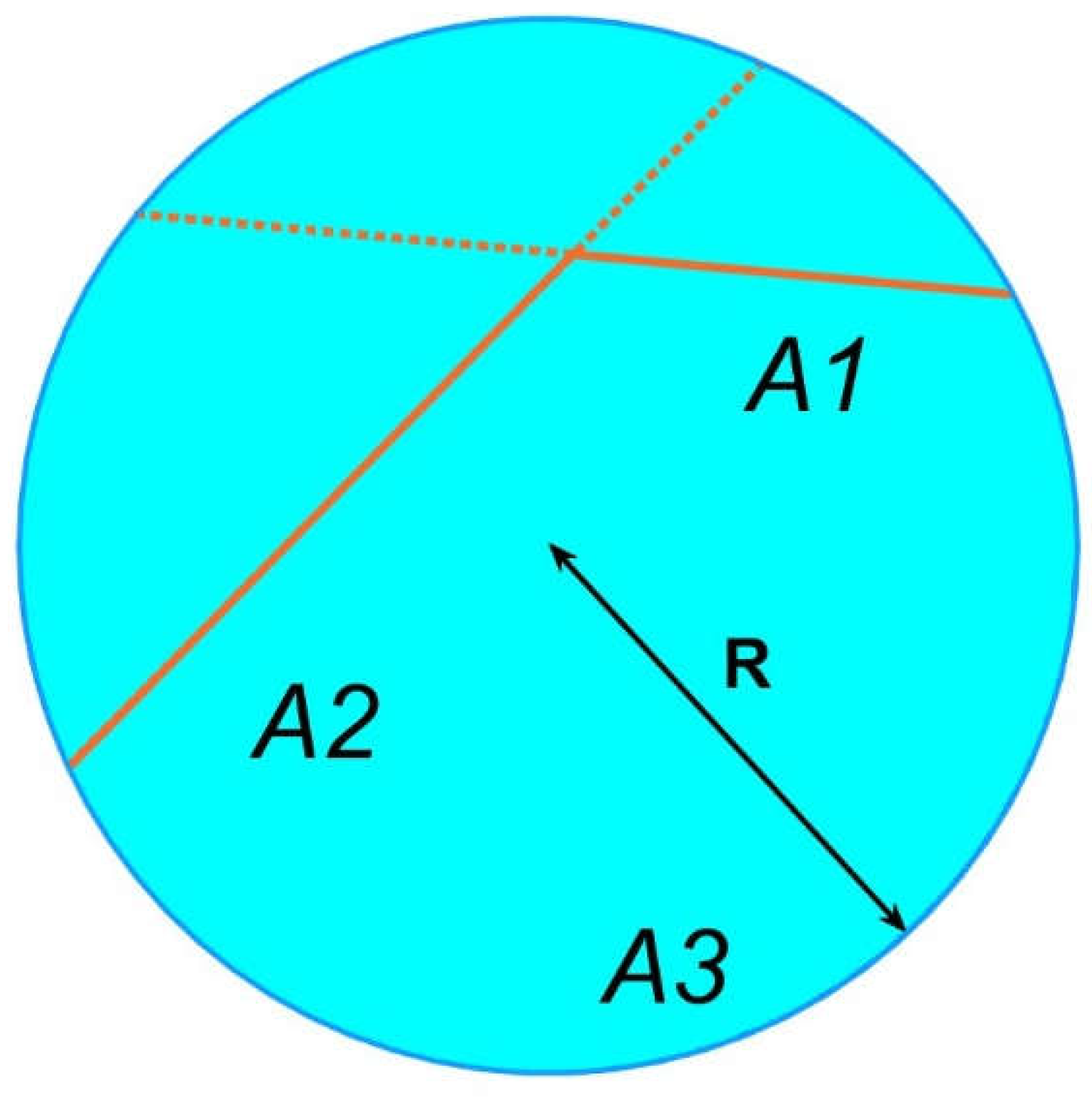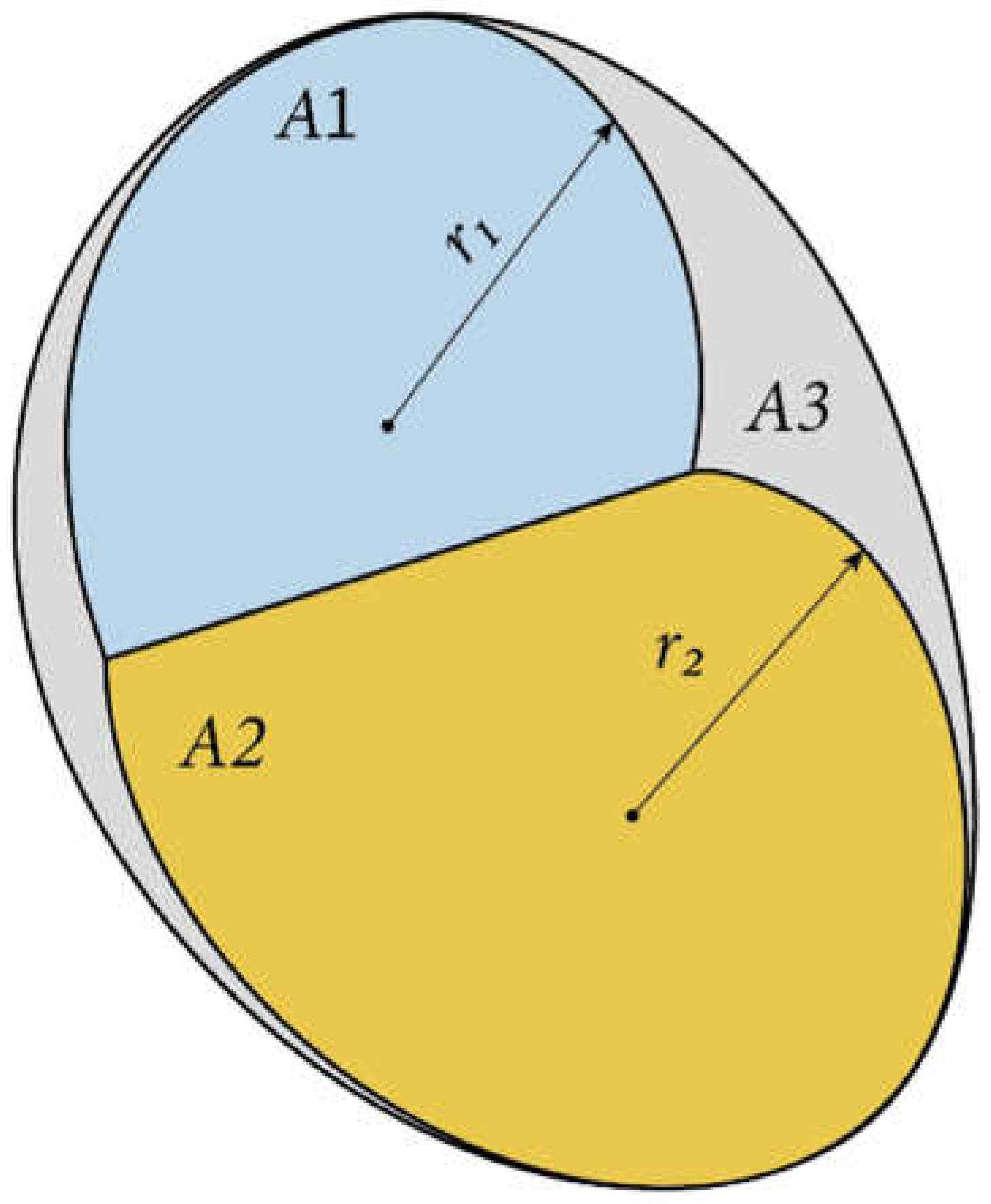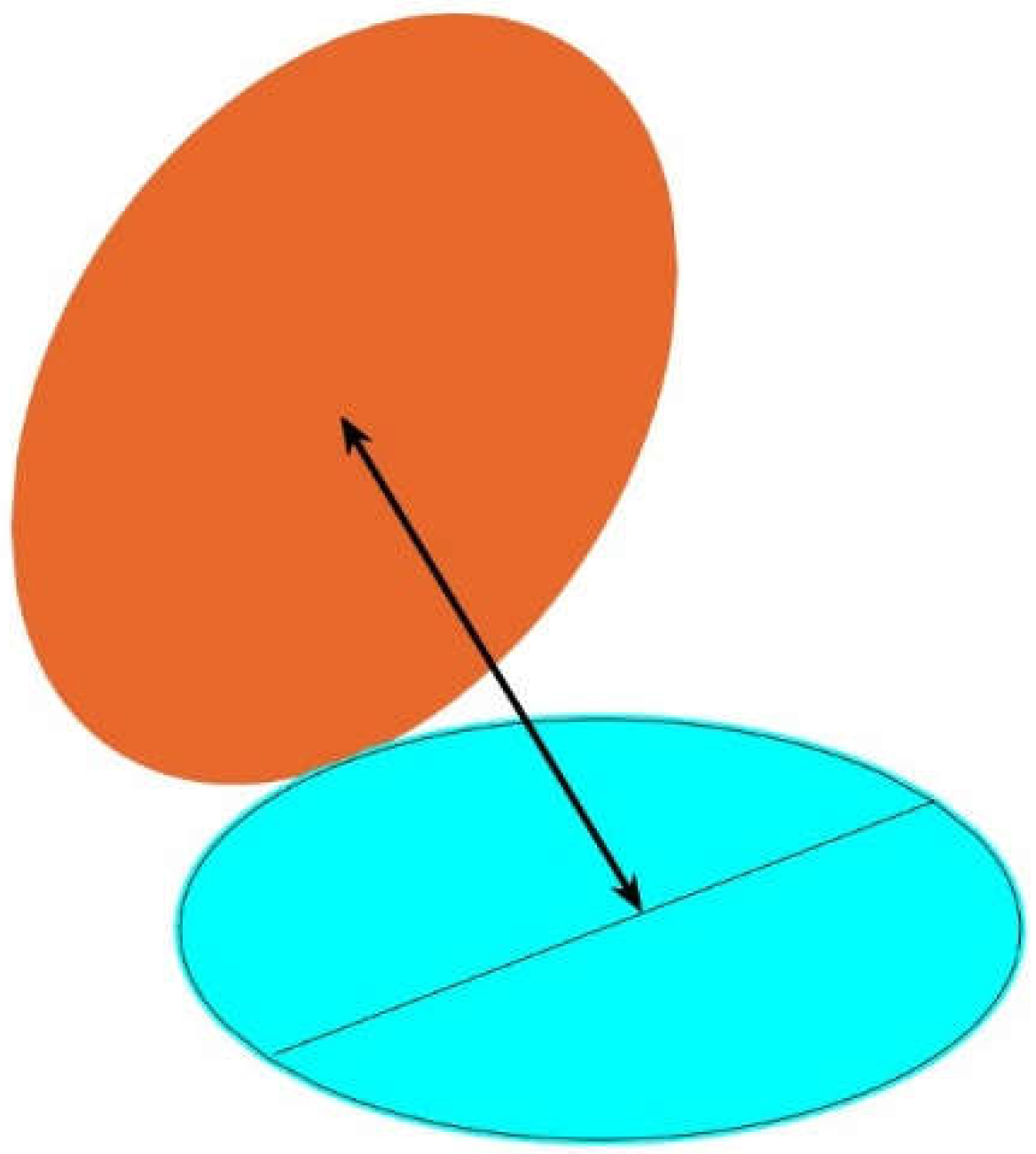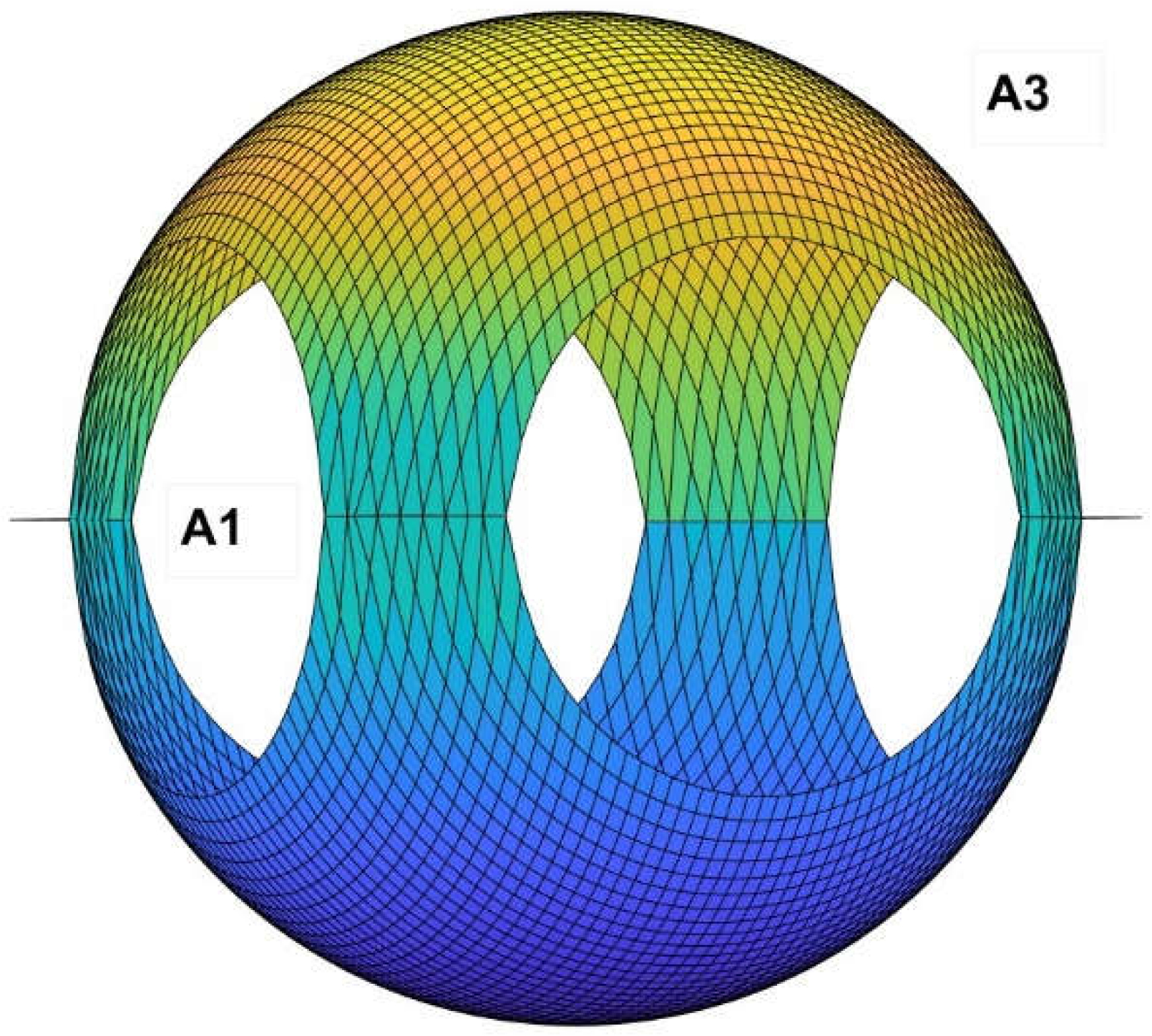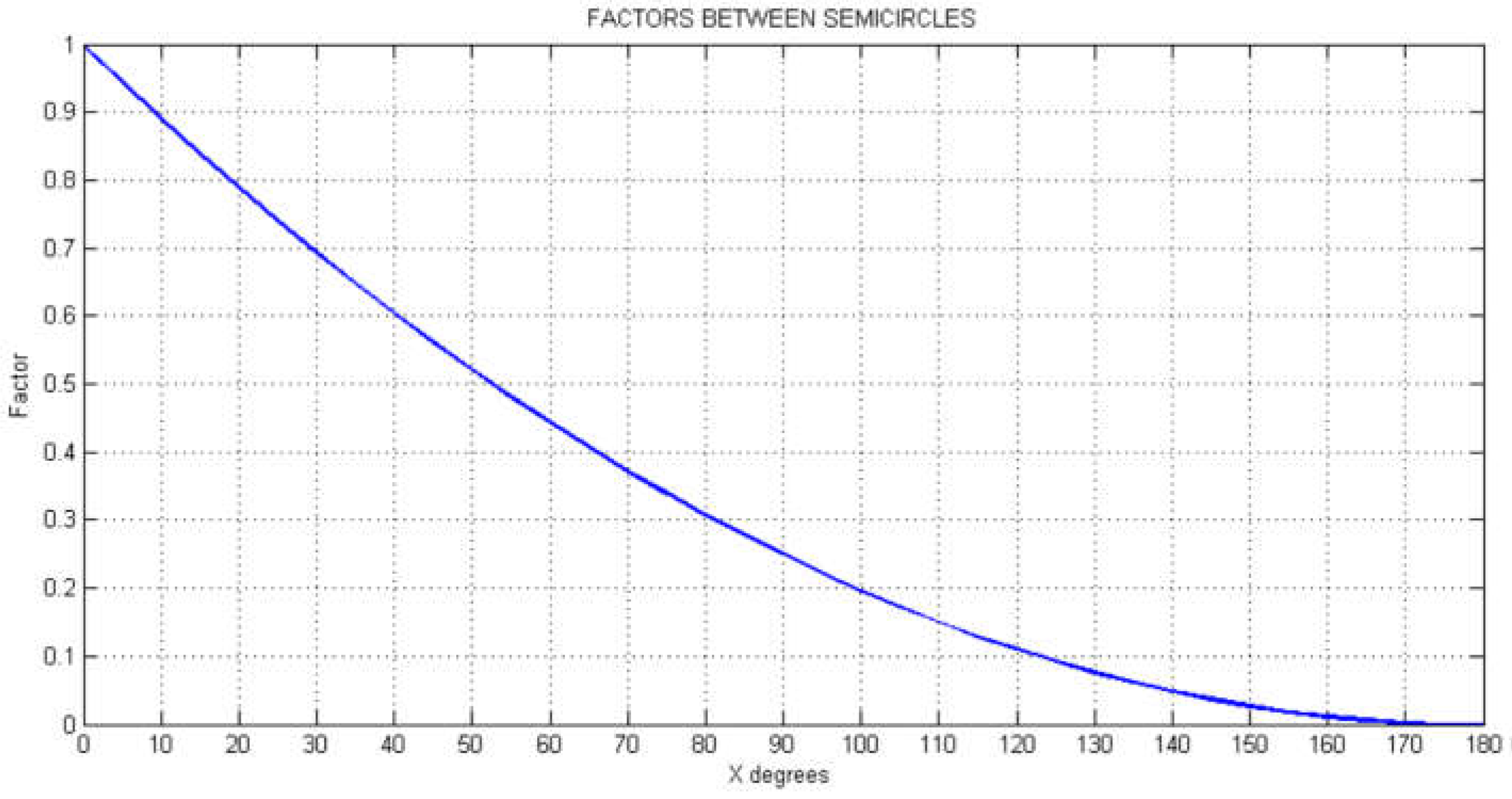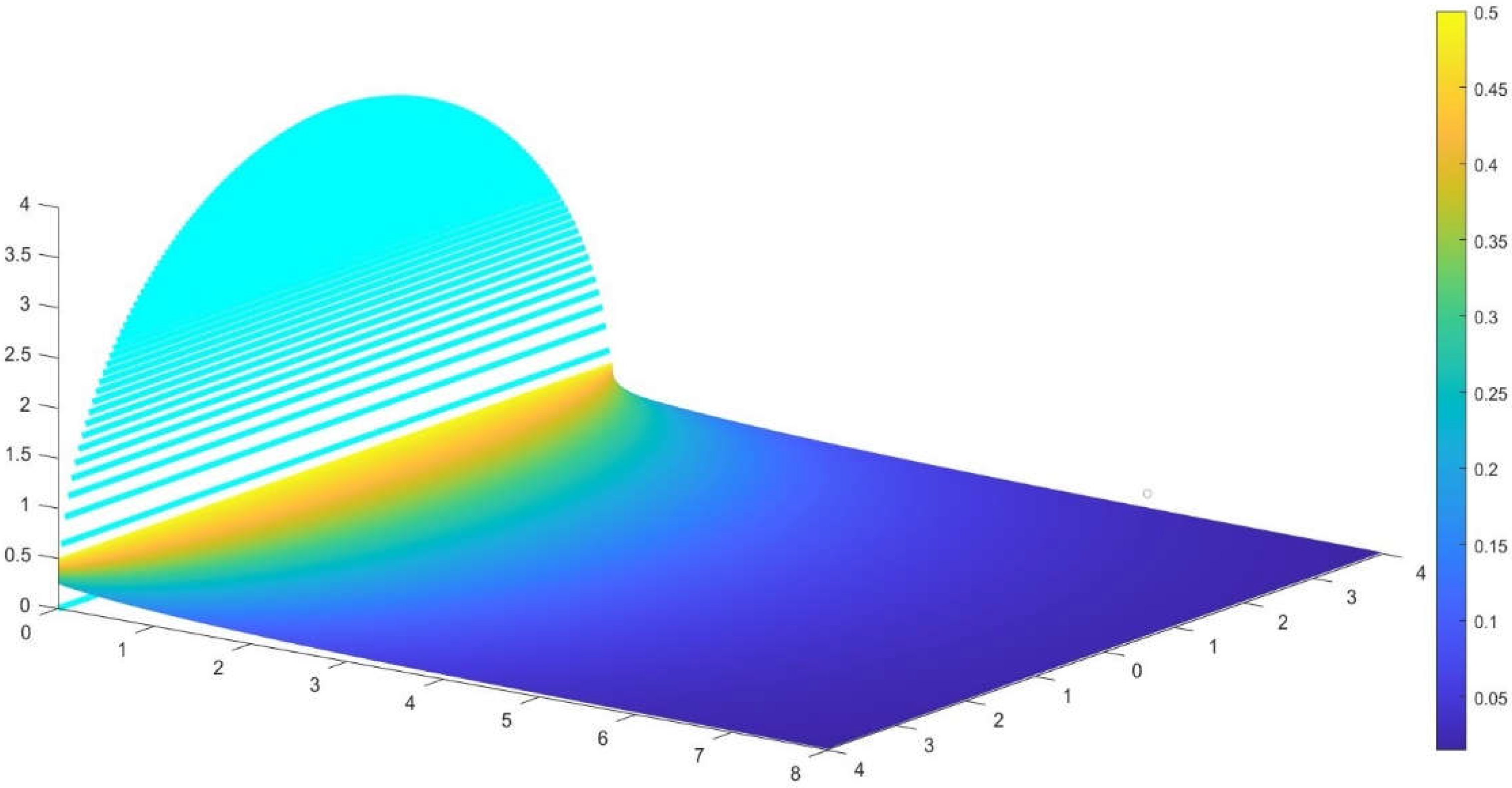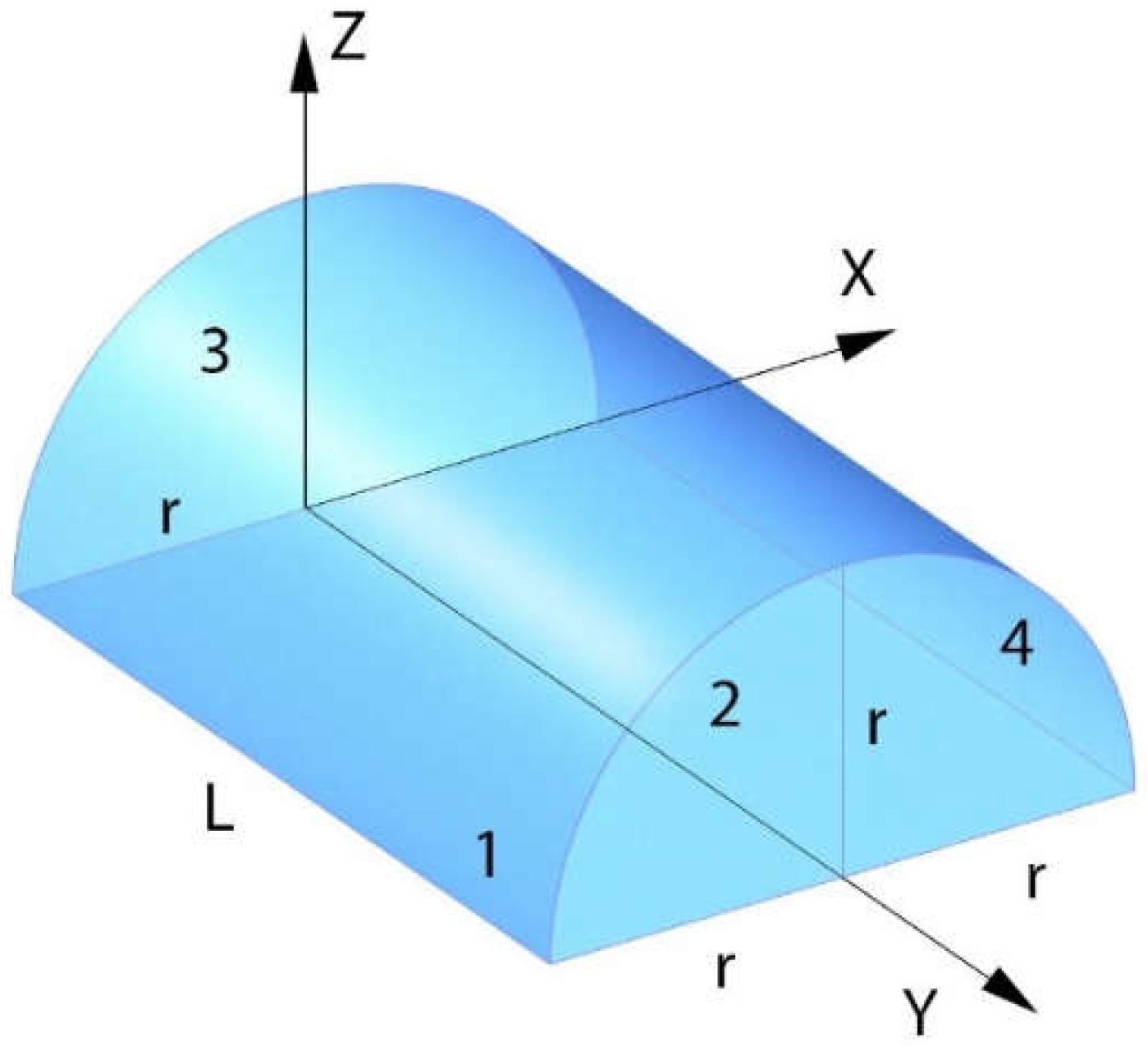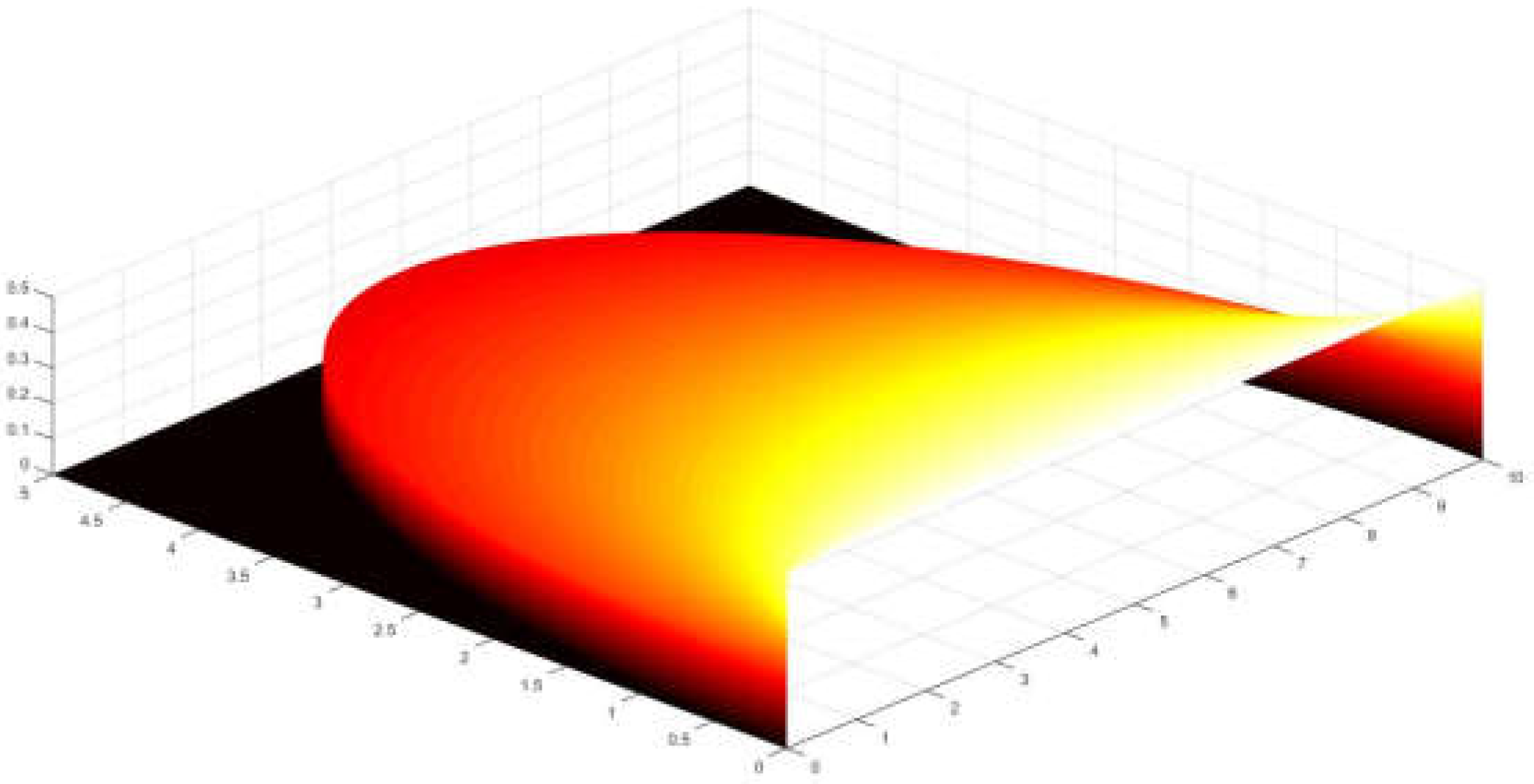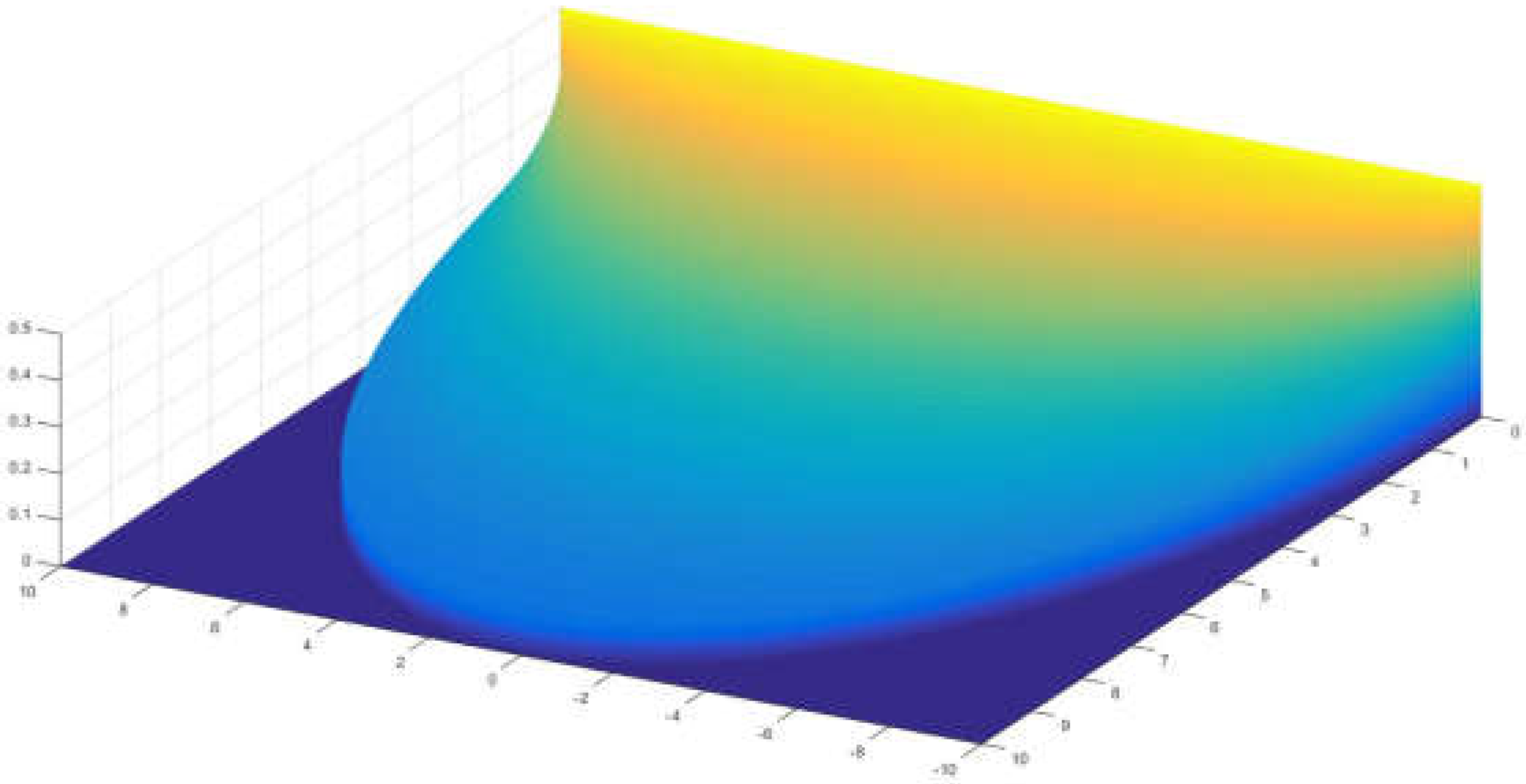1. Introduction
One of the main objectives of environmental sciences applied to architectural engineering has been to determine how the built environment is transformed due to the physiognomy of the constructions and how the design should be adjusted to obtain an improved climate performance [
1]. In other words, how to optimize the design to attain a satisfactory and coherent distribution of available energy. A similar problem appears in aerospace technology and industry for different reasons.
Spherical sources are extremely common in human designs or even natural forms, but their radiative performance in terms of heat transfer was not well-known. In this sense, the first principle of Cabeza-Lainez [
2], states that for a spherical surface numbered for convenience A
3, the so-called F
33 , that is the fraction of energy emitted by such sphere’s fragment over itself, is defined as the ratio between the area of the said fragment and the whole sphere (Equation (1)), i.e. ½ for a hemisphere, ¼ for a quarter of sphere and successively, due to its simplicity it constituted a paramount finding [
3].
It can be expressed algebraically as:
Therefore, this extremely complex factor if we were to calculate it with conventional methods equals the area of surface A
3 divided by the total area of the sphere, A
3/A
sphere, as in
Figure 1.
The first Cabeza-Lainez principle is compact and deft in the sense that it would be very difficult to solve the canonical expression described in Equation (2) in differential form regardless of the shape of the spherical fragment, [
4] while it is almost immediate to find the surface area of the same fragment.
In Equation (2), E1 and E2 the amounts of energy (in W/m2) emitted in Lambertian fashion by surfaces 1 and 2.
Figure 2.
The magnitudes involved in the expression for radiative exchanges due to manifold surface sources.
Figure 2.
The magnitudes involved in the expression for radiative exchanges due to manifold surface sources.
Besides θ1 and θ2, stand for the inclination angles formed by the perpendiculars to the unit area elements of area dA1 and dA2 if r12 is the vector that connects these surfaces dA1 and dA2.
Exact and complete solution of equation 2 is reserved, after lengthy calculations, to a few spare geometries, like rectangles and parallel concentric circles [
1].
3. Proof and Results
The form factor algebra demonstrated elsewhere [
1] states that,
In a volume composed by threes surfaces in the manner previously described (Fig. 5), a fragment of sphere (surface 3) and two limiting planar surfaces (areas 1 and 2), the sole reflexive or self-factor that appears is logically F33, which has been previously defined in Cabeza-Lainez’ first principle of form factors (Eq. 1) as the ratio between the surface area of the fragment of sphere and the total area of the sphere in which surface 3 is contained. F33 is therefore a constant for a given surface which belongs to the sphere.
Figure 5.
The three surfaces involved in radiative exchange for the third principle.
Figure 5.
The three surfaces involved in radiative exchange for the third principle.
In this situation if we apply the above algebra to find the unknown factors, we would find that,
But the form factor algebra applied to finite surfaces in a closed volume [
1] implies that:
From Equation (5) we know that,
Substituting (12) and (13) in (14)
Also substituting (11) in (15);
Multiplying by A
3 in both terms, we obtain
As (19) is equal to (3) the expression for the form factor has been demonstrated; QED.
Knowing F12, it is immediate to find F21 by using reciprocity theorem (11)
Consequently, we have arrived to the values of F23 (9), F13 (10), F32 (12) and F31 (13 and 14).
All the unknown factors of the problem are solved with perfect ease for a great variety of shapes previously unexplored.
Ensuing, let us check the form factor due to several typical configurations.
-
1.
Perpendicular circles within the sphere
We shall begin as is customary with perpendicular circles by virtue of Cabeza-Lainez’ 3
th principle,
Figure 6 and
Figure 7.
Figure 6 is and extreme case of
Figure 7 in which the perpendicular circles have been enlarged to become tangent.
The third principle, that we have seen in Equation (3) states that:
For any couple of planar sections of a sphere (1-2) with a common edge or point the form factor from surface 1 to surface 2 is:
And assuming that the area of the circles has to be πR
2/2 and A
1= A
2 , such equation turns out to be:
In this case, A
3 is found by subtraction of the area of the two identical caps to the sphere, and the area of one segment is π(a
2+ h
2), being h the height and a the radius of the base circumference of the cap. Theretofore, a=R√2/2 and h=R(1-√2/2),
and this yields,
,
An thus the sought factor F
12 is obtained as,
This value appears as the radiative exchange in a sort of cube composed of circles which in turn are enclosed in a fragment of sphere. The same value would be obtained for the parallell circles of the same figure. In the real cube of six squares [
1], the value of F
12 would be, as it is known, 1/5 = 0.2 , a very similar figure which attests to its validity.
In the fourth principle [
2], by logic deduction from the sphere, Cabeza-Lainez was able to obtain the form factor for semicircles of equal radius possessing a common edge, depending on the internal angle formed by the half disks α. Which was at the time a no minor feat. (Fig. 8).
Figure 8.
Two semicircles with a common edge.
Figure 8.
Two semicircles with a common edge.
In this case, the defining equation is,
Introducing the parameter p,
The equation, represented in
Figure 9 can be expressed as:
This factor may be seen as something obvious but if we were to look in more detail (Fig. 10),
Figure 10.
Radiative exchange between two semicircles forming a common angle α.
Figure 10.
Radiative exchange between two semicircles forming a common angle α.
The integral equation that we would be forced to solve would be for the semicircles (Eq.22),
Equation 22, which is only valid for α=π/2, describes the unusual complexity of the factor F12 to evaluate the radiative exchanges that occur in figures 8 and 10, such exchanges, are almost impossible to calculate even for the perpendicular angle not to mention any other inclinations, therefore the fourth principle can be considered as a pivotal advance, which is now subsumed in the third principle, as we will show. As it happens, the fourth principle was discovered before the third, but being less general, the author has decided to slightly alter the order.
Let us now proceed to check more examples based on the former.
-
2.
Calculations for an eighth of sphere.
The area of an octave of a sphere is , where α is the angle between two semicircles with a common edge. For the whole sphere α=2π.
In this case α=π/4 and A3= πR2/2
But we know by virtue of Cabeza’s first principle that .
That means the area of the octave of sphere divided by the total area
And applying the 3
rd principle to this particular case, from Equation (3),
Remember that A
1= A
2 =πR
2/2 and subsequently equal to A
3, to find that,
It is exactly the same result that can be obtained with Cabeza’s fourth principle, given that, in the latter expression we found the following (Equation (20)),
-
3.
Estimations for a fifth of sphere.
In one fifth of sphere, angle α=2π/5 (72º) and
-
4.
The case of a fourth of sphere.
If we had applied the same reasoning to a quarter of sphere, we would have obtained,
Which is already a familiar result by the fourth principle (see Fig.9 for a 90 deg. angle).
This value has also been experimentally verified through numerical calculus by Cabeza-Lainez. It is demonstrated that the value of a form factor between two surfaces is the average of configuration factor from receiving surface source over the whole emitting surface [
1]. Such demonstration has been used to check the value of 0.25 previously found(see section 7).
-
5.
Calculations for a third of sphere
For a third of sphere, angle α=2π/3 and
With the fourth principle we would have obtained,
It is the same result anew.
-
6.
Null case, half of a sphere.
In the particular case of a hemisphere Equation (3) provides,
As we already knew and could be expected since both semicircles are in the same plane and constitute a whole circle, no energy can be exchanged between them since they are one and the same planar surface.
It is henceforth clear that the third principle encompasses all the situations appearing in the more limited fourth principle but both are valid depending on the geometry of the case.
-
7.
Cases obtained by numerical calculus
As previously mentioned Cabeza-Lainez was capable of integrating the formula for radiative exchange from a semicircle [
3] over a rectangular field in 2013, but it laid dormant until 2018 for a series of calculation and representational difficulties (Equation (23)) (
Figure 11).
The meaning of the variables for the spatial directions is given in
Figure 12.
Equation (23) is a point by point distribution over x and y, stemming from the semicircle, but if it is averaged by numerical calculations over the second emitting source, the form factor can be obtained with sufficient accuracy.
The author has used this procedure in a perpendicular semicircle with the same radius (
Figure 13 and
Figure 14), to find the value of 0.25 obtained theoretically above in
Section 4.
The second example is the form factor between a semicircle and a perpendicular circular segment both contained in a sphere (
Figure 15 and
Figure 16). The numerical results closely agree with those using the third principle of Cabeza-Lainez.
Unfortunately, for shapes not perpendicular it is not currently possible to obtain a numercial verification although we are working on the issue. Due to the coherence and robust behaviour shown by the third principle in all the former instances we have every reason to believe that it will hold true when an experimental procedure is available in the near future.
Figure 15.
Form factor between a semicircle and a circular segment.
Figure 15.
Form factor between a semicircle and a circular segment.
Figure 16.
Numerical determination of the factor in plan.
Figure 16.
Numerical determination of the factor in plan.
4. Complementary Considerations for Inter-Reflections
A first consequence of obtaining the form factors in a volume composed of three surfaces by means of the third principle is that we need to complete the frame with the possibility of inter-reflections between the surfaces involved. This point has also been specifically developed by the author as follows.
The total balance of energy depends on the equation
where
Edir is the fraction of direct energy and
Eref is the reflected fraction. If these quantities are added, we obtain the global amount of radiation
Etot.
Usually, several surfaces intervene in the process of reflection, and thus a set of expressions can be built. It is possible to introduce a pair of instrumental arrays that we will call
Fd and
Fr. For the volume enclosed by the three surfaces (see
Figure 5), such matrices would have the ensuing form:
with factors
Fij as previously found, yielding the energy transfer between the respective surfaces involved. Here,
ρi represents the ratio of reflection (direct or otherwise) assigned to a particular element
i [
1,
7].
Notice that in the matrix called Fd (Equation (25)) the third element of the diagonal is not null as the Fii (with two ii) element has definite values for curved surfaces, unlike the exchange that happens in a cuboid.
If after careful integration by the procedures described in the previous sections, we are able to fix all the elements in Equations (25) and (26), we can establish new expressions (Equations (27)–(29)) in order to correlate the primary direct energy with the one extracted by reflections.
Thus the problem of radiating energy exchanges in the so-defined volume is completely settled.
The second issue that may appear is that as the planar surfaces that we have identified are usually the circular bases of caps belonging to the enveloping sphere, instead of finding the exchanges between the circles we would like to find the exchanges within the said caps.
We could resort to the original integration but we could use as well a new property that we have enunciated although it was not published before.
We have discovered that in certain cases involving circles the form factors have the commutative property, that is, a product of form factors is functional and not only addition.
The second principle of Cabeza-Lainez says that in a volume composed of two surfaces, the form factor exchange is proportional to the ratio of areas between the planar basis and the curved top surfaces [
2]. This principle is valid for forms other than the sphere but in the case of a spherical cap as we have here, the form factor depends on the relation between the area of the cap and the area of the base circle.
If we have for instance identified the form factor between two inner circles F
12, and then we have the form factor from this circle to the corresponding cap
, the final factor between the other circle and the said cap F would be the product of the two factors, that is,
